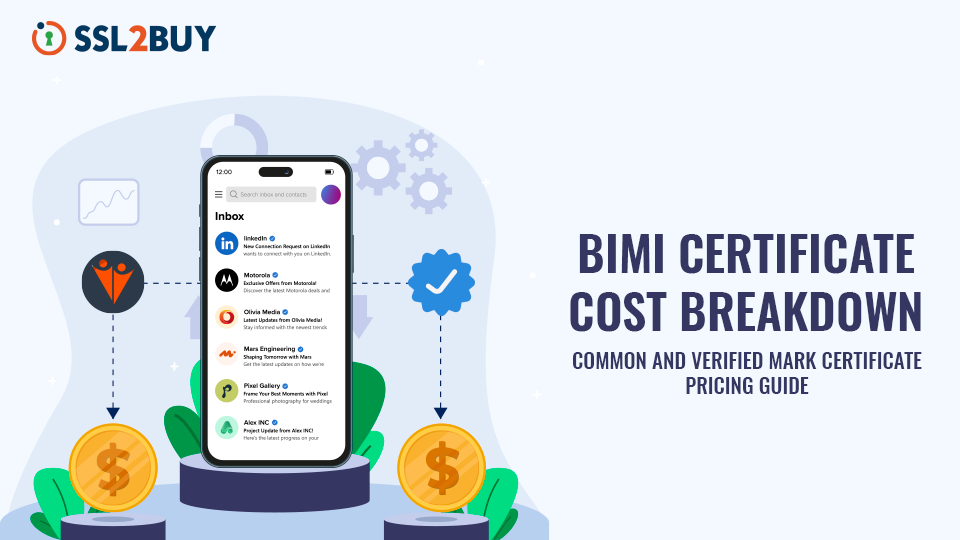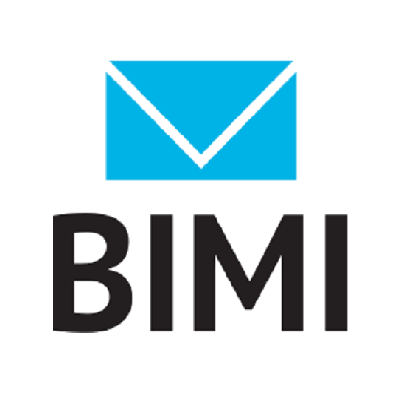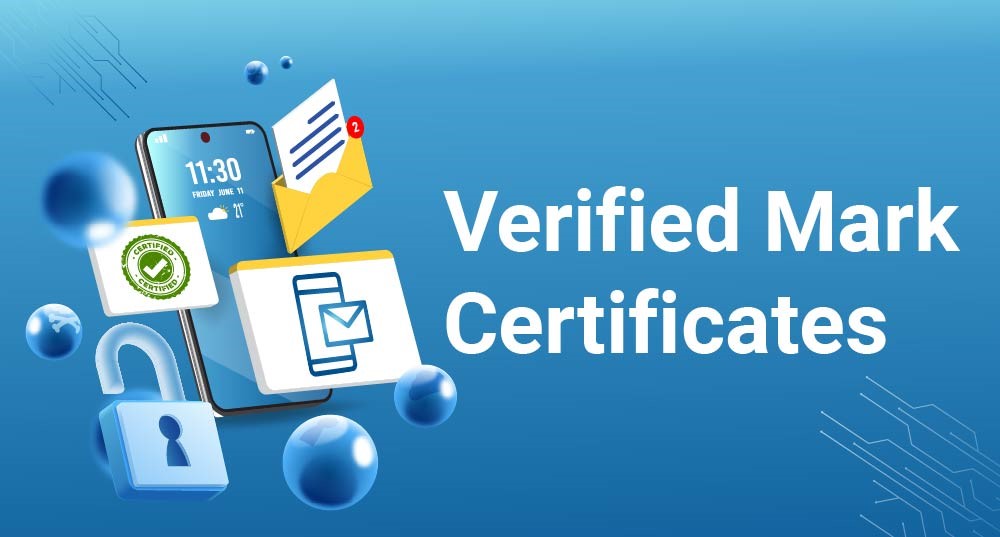Summary
Brand Indicators for Message Identification (BIMI) allows organizations to display their brand logo next to their email sender information in supported inboxes. A key component for enhanced trust with some mailbox providers is the Verified Mark Certificate (VMC), a digital certificate proving ownership of a trademarked logo. This page explores the financial and strategic considerations behind implementing BIMI with a VMC, drawing insights from industry discussions, expert opinions, and official documentation.
Key findings
- VMC cost: Verified Mark Certificates typically range from $1,000 to $1,500 annually. This cost is a primary concern for many businesses.
- Trademark requirement: To obtain a VMC, your brand logo must be a registered trademark, adding potential costs and time for legal processes (see BIMI Group FAQs for more). This extends the overall investment beyond just the certificate fee.
- Google's influence: Although VMC is not universally required for BIMI, Google's strong support for VMCs means that for many senders, a VMC is considered essential to display logos in the highly influential Gmail inbox.
- Distinction: It is important to distinguish between BIMI, the protocol for displaying logos, and VMC, a method of verifying logo ownership. Not all mailbox providers require a VMC for BIMI display.
Key considerations
- ROI justification: Businesses must carefully evaluate whether the investment in a VMC, including trademarking, justifies the potential benefits in brand recognition and trust. For more on this, see BIMI implementation costs.
- Accessibility for SMEs: The current cost structure may limit BIMI with VMC adoption primarily to larger enterprises, posing a challenge for small to medium-sized businesses.
- Prerequisites: Ensure your email authentication (SPF, DKIM, DMARC with a policy of enforcement) is fully implemented and aligned before considering a VMC. Learn more about the general BIMI requirements.
- Future evolution: The VMC landscape is still evolving, and future competition among Certificate Authorities or changes in mailbox provider policies could impact pricing and accessibility.
What email marketers say
Email marketers widely acknowledge the visual benefits of BIMI for brand recognition and trust. However, the associated costs, particularly for Verified Mark Certificates (VMCs), often lead to debates about accessibility and return on investment. Many marketers struggle to justify the expense, especially if their brand hasn't already invested in trademarking their logo.
Key opinions
- High barrier for SMEs: The pricing of VMCs, often over $1,000 annually (as seen on The SSL Store), is frequently cited as a 'show-stopper' for small and medium-sized businesses.
- Trademark complexity: The prerequisite of having a trademarked logo adds significant cost and time, making the overall BIMI with VMC implementation a complex and lengthy process.
- Value versus cost: Many marketers question the value proposition of paying a substantial fee simply to display a logo, especially when the logo is already authenticated by the domain and displayed on their website.
- Perceived exclusivity: There's a common sentiment that BIMI, particularly with VMC, is designed for big players due to the investment required.
- Engagement benefits: Despite cost concerns, marketers are generally positive about BIMI's potential to improve email engagement and brand recall. More details on how it improves engagement are available in What is BIMI's impact on email engagement metrics?.
Key considerations
- Budget allocation: Marketers must assess if the visual impact of a verified logo justifies diverting significant funds from other marketing initiatives.
- Prioritizing spend: For many, basic email authentication (SPF, DKIM, DMARC) and deliverability optimization might offer a greater return on investment before investing in VMCs.
- Client expectations: Managing client or stakeholder expectations regarding the cost and process of VMC acquisition is crucial, especially when aiming to display logos in inboxes.
- Alternative options: Some email clients may display BIMI logos without a VMC, offering a lower-cost entry point for brands to leverage the protocol.
Marketer view
Marketer from Email Geeks states that the VMC pricing acts as a significant barrier for many small businesses. They believe that the cost makes VMC adoption impractical, essentially acting as a 'show-stopper' for smaller organizations looking to leverage BIMI for brand recognition in email.
Marketer view
Email marketer from a marketing blog notes that many clients are interested in BIMI for increased brand visibility. However, when informed about the VMC requirement and its annual fee, their enthusiasm often wanes, indicating a perceived lack of immediate return on investment for smaller-scale operations. This highlights the challenge in justifying the expense.
What the experts say
Experts in email deliverability and security often provide a nuanced perspective on BIMI and VMC pricing. They emphasize the security and trust benefits that VMCs bring, particularly in the context of preventing brand impersonation and phishing. While acknowledging the costs, experts highlight the underlying value in cryptographic verification and the evolving landscape of email authentication.
Key opinions
- VMC as one method: Experts clarify that VMC is simply one method chosen by certain mailbox providers (MBPs) like Google to verify logos in a BIMI record. MBPs ultimately decide if they trust a logo, with or without a VMC.
- Security importance: The VMC's role in verifying trademark ownership adds a critical layer of security, enhancing the authenticity of displayed logos and helping combat phishing attacks.
- Balancing accessibility and security: There's a recognized tension between making BIMI widely accessible and maintaining robust security. Some experts prefer lower barriers to participation where possible, like Yahoo's approach.
- Google's impact: Despite the stated flexibility, Google's dominance often leads to the practical conclusion that a VMC is necessary for prominent logo display in a major portion of inboxes.
- Trust signals: VMCs provide stronger trust signals for mailbox providers, contributing to better informed decisions about displaying logos. This aligns with overall efforts to improve email deliverability.
Key considerations
- VMC necessity: While technically optional for BIMI, the practical reality of major mailbox provider support often makes a VMC a near-requirement for widespread logo display.
- CA landscape: The availability of multiple Certificate Authorities (CAs) issuing VMCs, such as DigiCert and others, could introduce more competitive pricing over time (see Is DigiCert the only VMC issuer? for further insights).
- Value of verification: The cost of a VMC reflects the rigorous identity and trademark verification process, which contributes significantly to the integrity of the email ecosystem.
- Long-term strategy: Brands should view VMC implementation as a long-term investment in brand security and trust, rather than a short-term marketing tactic.
Expert view
Expert from Email Geeks clarifies that BIMI and VMC are not synonymous. They note that VMC is merely one method chosen by some mailbox providers, like Google and Fastmail, to verify a logo published in a BIMI record. Email providers retain the discretion to decide whether to trust a logo, with or without a VMC.
Expert view
Email deliverability expert from Word to the Wise asserts that while the cost of VMCs might seem steep to some, they represent an essential component for certain mailbox providers (such as Google) to confidently display brand logos. This necessity stems from the robust identity verification that VMCs provide, with their core value lying in enhanced email security and the authentication of brand identity.
What the documentation says
Official documentation and technical specifications provide the foundational understanding of BIMI and VMC. They clarify the roles of various components, the verification processes involved, and the conditions under which brand logos are displayed. This information is crucial for implementing BIMI correctly and understanding the security implications of VMCs.
Key findings
- VMC purpose: A VMC provides cryptographic assurance that a specific brand logo is authentic and legally owned, which is essential for certain mailbox providers to display the logo confidently.
- Trademark requirement (formal): For a VMC, the logo must be a registered trademark in a recognized jurisdiction, and the VMC must be issued by a Certificate Authority (CA) accredited by participating mailbox providers.
- Mailbox provider discretion: While BIMI allows senders to suggest a logo, the ultimate decision to display it, with or without a VMC, rests with the individual Mailbox Provider (e.g., as outlined in Verizon Media's BIMI documentation).
- Enhanced security: VMCs strengthen BIMI's security posture by ensuring only legitimate, trademarked logos are used, thereby reducing brand impersonation and enhancing trust (as explained by GoDMARC).
Key considerations
- DMARC prerequisite: BIMI requires a DMARC policy set to quarantine or reject. Understanding DKIM, SPF, and DMARC is foundational before pursuing VMC.
- CA selection: Choose a VMC provider that is accredited and recognized by the key mailbox providers you target. A guide to BIMI accredited certificate providers can assist with this.
- Technical requirements: The BIMI logo (SVG file) and its hosting must meet specific technical standards for proper display. The VMC then cryptographically links this logo to your domain.
- Cost components: Pricing for VMCs includes not only the certificate issuance but also the extensive validation process and ongoing certificate maintenance by the Certificate Authority.
Technical article
BIMI Group documentation outlines that the primary purpose of a Verified Mark Certificate (VMC) is to provide cryptographic assurance that a specific brand logo is authentic and legally owned by the sender. This verification is crucial for certain Mailbox Providers (MBPs) to display the logo confidently alongside authenticated emails, thereby enhancing trust and brand recognition for recipients. It forms a vital link between the authenticated email sender and their visual brand identity.
Technical article
Documentation from developer.verizonmedia.com states that while BIMI itself is designed to empower senders with control over their brand logo in email, the final decision to display a logo, whether supported by a VMC or not, ultimately resides with the individual Mailbox Provider. Some providers may indeed opt for VMC-verified logos to ensure higher assurance and security, while others might allow logo display based on a broader set of other established trust signals and authentication measures.
Related resources
5 resources
Related pages
What are the costs and steps for implementing BIMI (Brand Indicators for Message Identification)?
What are the requirements and implementation steps for BIMI?
Is DigiCert the only working VMC issuer for Google BIMI?
What is BIMI's impact on email engagement metrics?
How do I display my logo in email inboxes, particularly Gmail, and what are the BIMI requirements?
A guide to BIMI accredited certificate providers
Does BIMI improve email deliverability?
What are best practices and costs for implementing DKIM, SPF, and DMARC?
Understanding the business value and ROI of implementing BIMI
Which email clients actually support BIMI?





